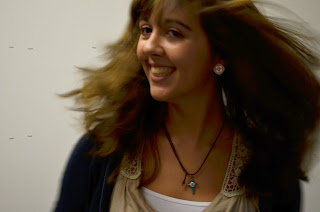In all of the images I have found appealing and inspiring, the texture is the main focus. The movement of hair, of the body and of garments. Distorted effects manipulated onto the image. The effect of a liquid thrown at models. I could incorporate all these aspects of fashion photography into my own fashion shoot to create my own set of images that I an be proud of.
but before I leap straight into it i want to experiment with movement, liquids, and any other textures that I could incorporate into a fashion shoot.
For the first experiment I wanted to visualise the diffusion of ink in water. I used a small clear plastic cup so I could capture the movement of the ink in the water. it was only an experiment so i only used a little lamp for my lighting and a sheet of white paper to place the cup on. I had a friend help me pour the liquid in as I took the snap shots. I loved how the colours varied from light to dark and the ink moved in an abstract way. the texture is beautifull and if i took a few images of profiles, or fashion photos, i could manipulate the liquid onto the image to create images similar to "Pirelli's Calendar" to give a distorted effect to a profile image.
 I decided to experiment with movement as when taking images of models the movement in their hair can distract the viewer as strands may be in front of the face, or the texture and shape of the hair may not suit the image. I decided to do some hair wipping just a fe littel experiments with a few volunteers.
I decided to experiment with movement as when taking images of models the movement in their hair can distract the viewer as strands may be in front of the face, or the texture and shape of the hair may not suit the image. I decided to do some hair wipping just a fe littel experiments with a few volunteers.One of my favourite images was of two of my friends, Sean and Jonny, who both have extremely curly hair. i thought it would be perfect as the texture of their hair makes the movement much more detailed.
I also experimented with the shutter speed to see if i could capture the movement in progress. I had the shutter speed on 2 and took the photo as her head sprung upwards and ended up eith this. i thought the opacity of her face made the image more elegant but i think the eye is to drawn to her back as the colour palet is much darker.
After some hair wipping I went out with three friends to Mudeford Quay. It was a realy clear day but with strong winds which was ideal for my hair experiments.
After some hair wipping I went out with three friends to Mudeford Quay. It was a realy clear day but with strong winds which was ideal for my hair experiments.
I wanted a nice backdrop behind my friends so as we walked right by the harbour i chose to taek the shots. I didnt want them to pose or look too structured so as they were wondering around I just took the shots as the wind blew through their hair.
The natural light added shadows to her skin and brought out the structure of her face but also added highlights to the differnt strands of hair. i would love to do a massive fashion shoot on a windy sunny day to capture the abstract texture and natural lighting in the images.
My friend Aaron was just wondering about and i took a sequence of images as he stood in front of the backdrop of hengistbry head. this one was my favourite due to the spikyness of his hair. i also like how the light doesnt shine on him, but only on hengisbry head. Also i love the contrast of the lighter background and the darker colour palet of the model.
 I also took a photo of my freind emma but i wanted a close up and just a simple coloured backdrop so the eyes attention was focused on her hair. It was taken whilst along the beech with just the blue sky as a backdrop which I thought made the photo much simpler and made the differnt stands of hair more visible. Also thelighting is quite simple due to the sun shining on her face like the one of rachel the structure of her face is outlined by the shadows.
I also took a photo of my freind emma but i wanted a close up and just a simple coloured backdrop so the eyes attention was focused on her hair. It was taken whilst along the beech with just the blue sky as a backdrop which I thought made the photo much simpler and made the differnt stands of hair more visible. Also thelighting is quite simple due to the sun shining on her face like the one of rachel the structure of her face is outlined by the shadows. 






























